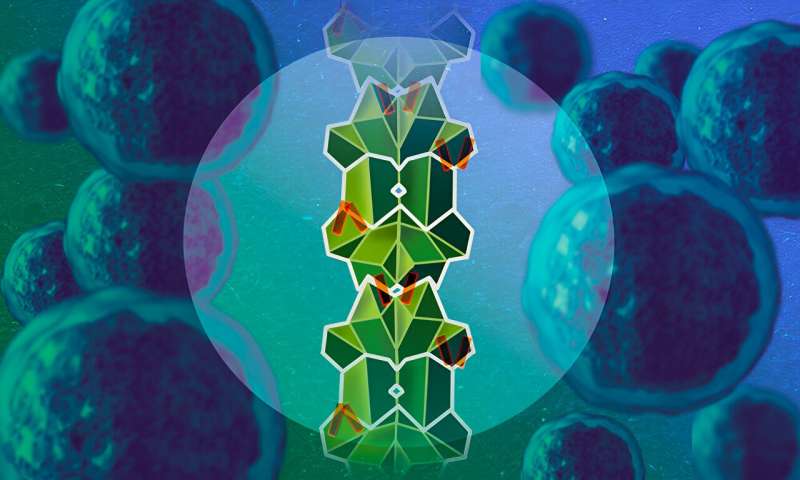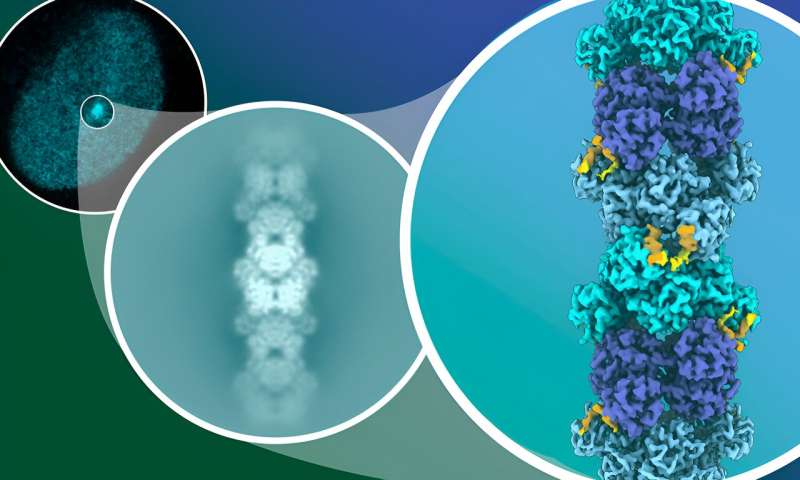This article has been reviewed according to Science X's editorial process and policies. Editors have highlighted the following attributes while ensuring the content's credibility:
fact-checked
peer-reviewed publication
trusted source
proofread
Scientists reveal how an unstructured protein traps cancer-promoting molecules

Each second of our lives, cells in our body grow and divide to ensure we stay healthy. However, this process has a dark side: if cell growth and divisions become excessive, that may cause cancer. To keep a safe balance, our cells are equipped with several molecular mechanisms to limit their own growth and division.
EMBL Hamburg's Wilmanns Group, in collaboration with research groups from the Center for Experimental Medicine Institute of Tumor Biology and the Martini Clinic at the University Medical Center Hamburg-Eppendorf (UKE), as well as the Leibniz Institute on Aging-Fritz Lipmann Institute, has revealed a new mechanism through which cells counteract one of the main cancer-promoting proteins by stacking and fixing its molecules in a pile. The findings shed light on how prostate cancer advances from treatable to aggressive, treatment-resistant stages.
The work is published in the journal Nature Communications.
A villain and a hero
Their discovery, like a good novel, has a villain and a hero.
The "villain" in this story is a group of proteins, called CtBPs (C-terminal binding proteins), which regulate the activity of several genes involved in cell growth and division. In various studies, CtBPs have been demonstrated to participate in promoting the development of cancer.
But the cell has its ways to harness the villain—that's where the "hero" comes in: protein RAI2 (Retinoic Acid-Induced 2). RAI2 was only discovered recently, and even though it's present in the cell in small amounts, it has been shown to play a role in preventing cancer metastasis. However, until now, it has been unclear how it achieves this.
The scientists have discovered that RAI2 has a remarkable ability to seize CtBP molecules and stack them together in a process called polymerization. As they get piled up, the CtBP molecules form elongated aggregates in cancer cell lines, described as "nuclear foci." Trapped and stacked by RAI2 in the aggregate, CtBP, the villain, becomes inactive.
"Polymerization has become an emerging field of interest in the life sciences, but to our knowledge, it has not been described to date in the context of interfering with cancer progression," said Matthias Wilmanns, Group Leader at EMBL Hamburg. "The discovery of this new mechanism of powerful target inhibition could open up new anti-cancer therapy directions, such as developing small molecules with potential or cancer target polymerization."

An invisible hero
To structural biologists like the Wilmanns Group, RAI2, the hero, is essentially an invisible protein. While the majority of proteins, like origami, fold into 3D structures, RAI2 rather resembles a flexible band that keeps changing shape. Capturing such a wobbly protein in high resolution is impossible with the currently available structural biology techniques.
"You could compare it to trying to take a photo of a moving object at night—what you'll get is a blurry image," said Wilmanns.
In this study, the only parts of RAI2 that could be visualized in the molecular model were the only parts that would stand still—the "sticky" fragments through which RAI2 binds CtBPs. Each RAI2 molecule has two such fragments (depicted in orange in the images), which enable it, akin to adhesive tape, to glue two CtBP molecules together.
"Wobbly proteins like RAI2 are challenging to work with, so this project took lots of hard work, focus, determination, and a 'never give up' attitude," said Nishit Goradia, previously a postdoc in the Wilmanns Group, currently a fellow at the UKE.
"We've revealed that RAI2 is a real dark horse. Like other wobbly proteins, it's quite understudied, but it holds true potential for inactivating cancer-promoting proteins. For me, this has been a career-defining project and I'm proud of this achievement."
Wobbly protein in prostate cancer
To check whether the new mechanism plays a role in human cancer, the scientists analyzed, in addition to cancer cell lines, cancer samples from a diverse cohort of more than 100 patients of the UKE's University Cancer Center Hamburg and Martini Clinic. They focused on prostate cancer, the second most common type of cancer in men and the third leading cause of cancer related death.
In the course of therapy, prostate cancer may develop resistance to treatment, resulting in very poor prognosis for the patients. However, it is not yet fully understood why some forms of prostate cancer develop into certain highly aggressive subtypes, and others don't. RAI2 could play a key role here.
In both tumor cell lines and samples from patients, the scientists saw that the RAI2 levels were strongly reduced in more severe and treatment-resistant types of prostate cancer. In analyses in vitro, they saw that loss of RAI2 favors cellular processes that may lead to resistance to certain types of treatment.
"Even if we are not yet able to use this result therapeutically, it is a decisive step towards better understanding how a very aggressive subtype of prostate cancer develops," said Gunhild von Amsberg, Professor of Uro-oncology at the University Cancer Center Hamburg and the Martini Clinic. "An important next step will be to transfer our findings to the clinic and thus identify patients who may be at risk at an early stage."
Although the analysis focused on prostate cancer, the scientists suspect that the significance of their discovery maybe be applicable to other cancers too.
Molecular biology meets the clinics
The study is part of the long-standing collaboration between EMBL and UKE and showcases the benefits of combining both institutions' complementary scientific approaches. While the UKE conducts a large spectrum of medical projects, in part based on patient data, EMBL contributes expertise in studying life across biological scales, including investigating disease mechanisms at the molecular and cellular levels.
"This work demonstrates the future perspective of collaboration between molecular biology and the clinics to unlock research 'from molecules to patients,'" said Wilmanns.
More information: Nishit Goradia et al, Master corepressor inactivation through multivalent SLiM-induced polymerization mediated by the oncogene suppressor RAI2, Nature Communications (2024). DOI: 10.1038/s41467-024-49488-3

















